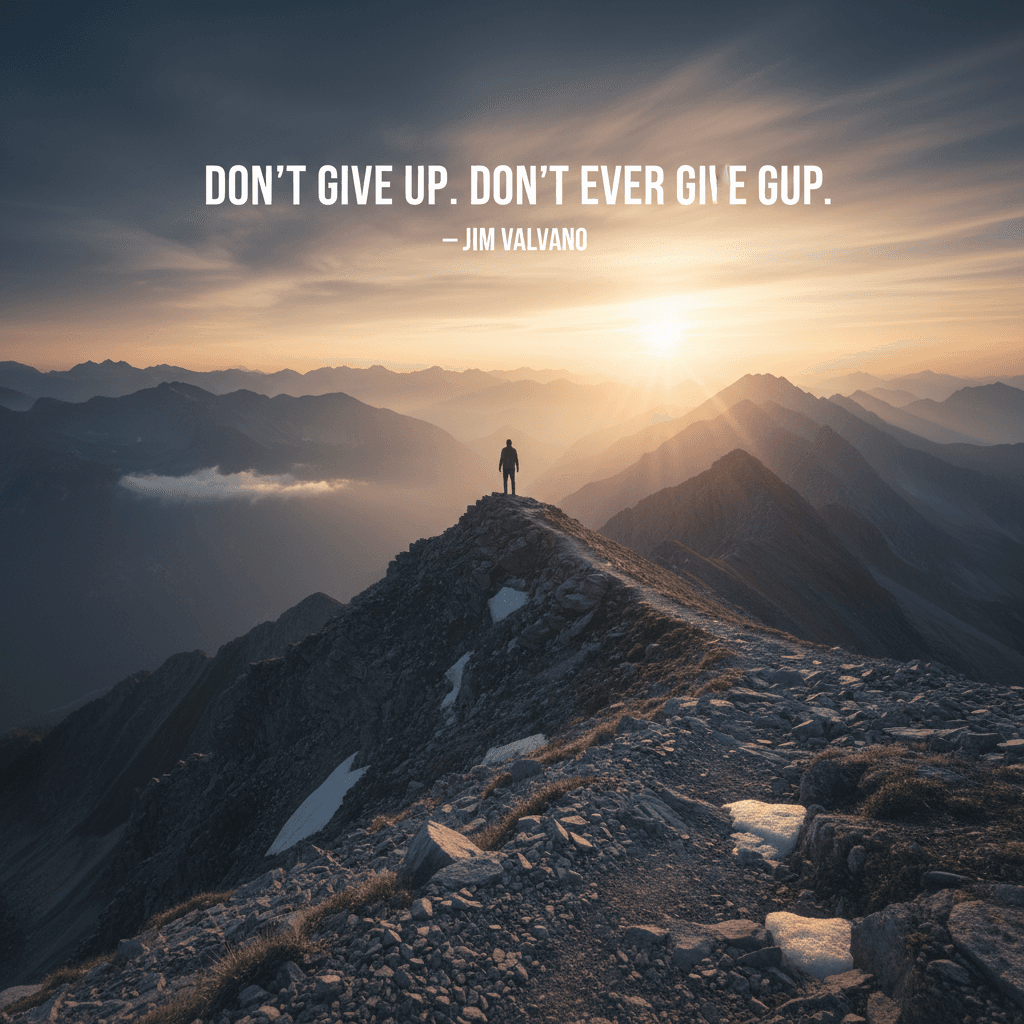The Courage to Never, Ever Give Up

Don't give up. Don't ever give up. — Jim Valvano
From a Stage to a Movement
Jim Valvano’s words—“Don’t give up. Don’t ever give up.”—rang out at the 1993 ESPYs as he stood weakened by cancer yet brimming with humor and defiance. In that speech, he reminded viewers that “time is very precious,” insisting that purpose thrives even under mortal pressure. With ESPN, he launched the V Foundation that night, turning a personal battle into a public mission for hope and funding. The phrase became more than encouragement; it became a compass. As the applause faded, the directive remained: perseverance is not simply a feeling but a decision repeated daily, especially when circumstances conspire to extinguish resolve.
Why Persistence Works: Mind and Motivation
From there, psychology helps explain why Valvano’s maxim endures. Angela Duckworth’s Grit (2016) argues that sustained passion plus perseverance predicts long-term achievement, while Carol Dweck’s Mindset (2006) shows how a growth mindset reframes setbacks as feedback rather than verdicts. Moreover, research on deliberate practice indicates that skill deepens through targeted, effortful repetition. These findings converge on a simple insight: persistence transforms time into capability. And yet the science also humanizes the process, showing that motivation is not constant; it is cultivated by purpose, progress tracking, and supportive relationships—exactly the networks Valvano urged people to build.
Game-Time Proof: Valvano’s Own Upsets
Consider Valvano’s 1983 NC State team, the “Cardiac Pack,” which refused the odds and won the NCAA title with Lorenzo Charles’s last-second dunk. Their mantra, later immortalized by the ESPN documentary Survive and Advance (2013), mirrored the coach’s credo: keep believing, keep executing. The broader sports canon echoes this script—from Michael Jordan’s “Flu Game” in the 1997 NBA Finals to Derek Redmond’s 1992 Olympic 400m, finished arm-in-arm with his father. These moments don’t romanticize pain; rather, they reveal the alchemy by which persistence turns adversity into meaning, inviting spectators to ask where they might push one more step.
Everyday Tenacity Beyond the Arena
Beyond sports, perseverance animates ordinary lives. J. K. Rowling famously faced multiple rejections before a publisher took a chance on Harry Potter, reminding us that gatekeepers often misjudge early potential. Similarly, job seekers send dozens of applications, patients endure long treatment regimens, and caregivers show up daily without applause. The point is not that effort guarantees triumph, but that consistent effort multiplies opportunities for luck to land. In Valvano’s own phrasing, you laugh, you think, you cry each day—emotions braided with action—so that each sunrise finds you a little stronger than the one before.
Knowing When Persistence Needs a Pivot
Even so, never giving up does not mean never adapting. Meta-analytic work by Marcus Credé et al. (2017) suggests grit’s incremental power over conscientiousness is modest, implying that strategy and fit still matter. Likewise, Annie Duke’s Quit (2022) and Barry Staw’s research on escalation of commitment (1976) warn against clinging to failing paths. The wiser reading of Valvano’s line is: don’t abandon the ultimate goal, but pivot tactics relentlessly. In other words, persist in purpose, not in error. That way, resilience becomes intelligent endurance—capable of course-correcting without surrendering the mission.
Practices That Sustain Perseverance
In practice, persistence is a system. Define a why that survives bad days; then translate it into small, scheduled actions. Use implementation intentions—“If it’s 6 a.m., then I run”—as Peter Gollwitzer’s work (1999) recommends. Track leading indicators, recruit accountability partners, and schedule rest like training, because recovery protects consistency. Crucially, rehearse setbacks: pre-commit to your response when motivation dips. And borrow Valvano’s daily triad—laugh, think, cry—as an emotional routine that keeps purpose vivid. Over time, these habits convert inspiration into traction, turning a stirring line into a lived roadmap.
A Legacy of Hope that Funds Cures
Ultimately, Valvano’s exhortation matured into concrete help. The V Foundation for Cancer Research reports awarding more than $310 million in grants, with 100% of direct donations to research supported by an endowment (v.org). That financial architecture embodies his promise: words backed by action, action backed by results. So when we hear, “Don’t give up. Don’t ever give up,” we are not being asked to admire bravery from afar; we are being invited to join a lineage of determined helpers—people who transform endurance into treatments, and treatments into time.